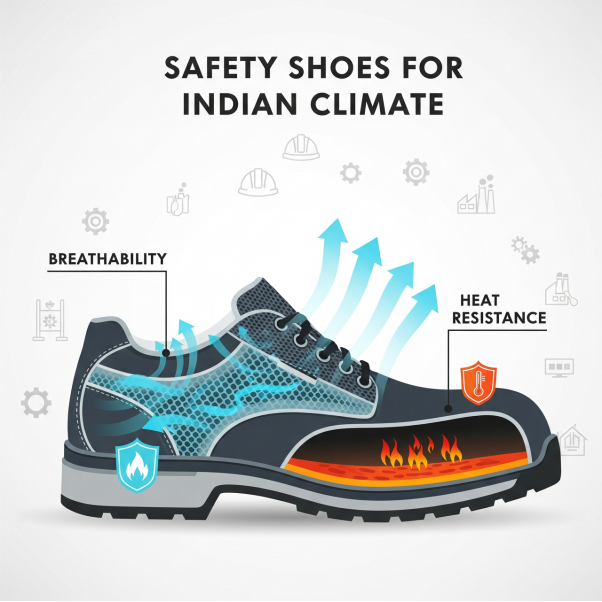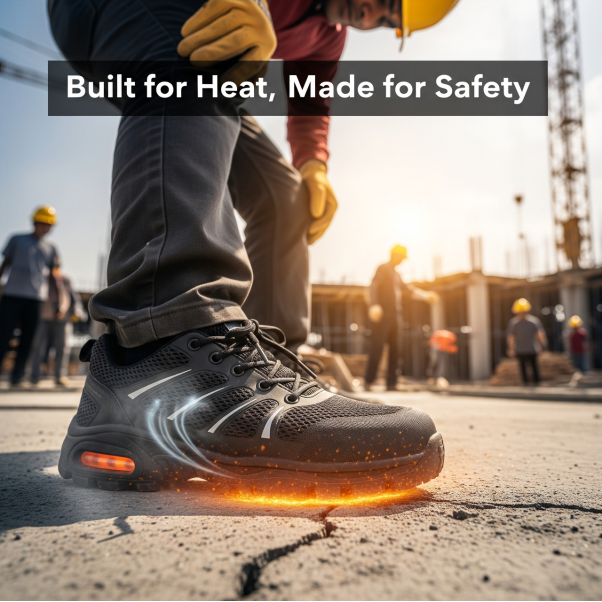The development in India is getting speedy each day—so is the demand for workforce—helping the nation to build and progress. From industries to construction sites, manufacturing enterprises, modern logistics, and warehouses everywhere, the need for quality safety gears, including footwear, isn’t negotiable.
Ensuring the protection of workers and labourers from falling objects, electrical risks, sharp surfaces, heat, chemicals, and more is achieved through the use of high-quality safety shoes. However, the primary goal needs to be the Indian climate, introducing the challenge of intense heat and humidity that increases foot fatigue for workers.
Exposure to soaring temperatures and long hours outdoors can cause feet to become sweaty, tired, and prone to discomfort & infections. Thus, the need for modern innovations, many Safety shoe brands are focused on protection, while maintaining breathability and heat resistance. Let’s not debate here anymore and find the perfect solution for keeping feet safe and comfortable.
The Indian Climate Challenge
India’s varied climate brings extremes:
- Hot summers in most regions where temperatures can easily touch 40°C and beyond.
- High humidity in coastal states leads to sweat accumulation.
- Dusty and dry conditions in central and northern zones cause materials to wear down.
- Unexpected rains in monsoon seasons often turn worksites slippery.
In these conditions, wearing heavy, non-breathable safety footwear can result in:
- Excessive sweating and odour
- Fungal infections
- Blisters and rashes
- Early fatigue from carrying extra weight
Ensure the design of safety shoes is best for workers in the Indian climate environment—striking a balance between strong protection and climate-friendly comfort.

Key Elements of Climate-Friendly Safety Shoe Design
Breathable Materials
When starting with the material, ensure the upper portion of the shoe is made of leather, synthetic fabrics, or mesh. Thus, suitable for Indian conditions—
- Perforated leather or engineered mesh allows air circulation.
- Fabrics with moisture-wicking properties keep feet dry during humid conditions.
- Lightweight linings reduce heat buildup compared to dense padding.
Understand this—breathability isn’t linked to compromise on protection. Even the High Ankle Safety Shoes are designed to provide feet with proper ventilation, ensuring good airflow without compromising their structure.
Heat-Resistant Soles
Worksites, especially construction zones—exposed to heated concretes, metal surfaces, and more in such cases—
- Heat-resistant soles can withstand temperatures up to 200–300°C, protecting workers from burns.
- Materials like nitrile rubber or specialized PU compounds perform better in high-heat settings.
- Welders benefit from soles that don’t easily degrade when sparks or hot metal fragments fall on them.
When selecting protective footwear, look for Safety Shoes Brands that offer quality resistance to heat. The protection should be overall foot protection, which necessitates an upper that resists sparks and molten splashes.
Moisture and Sweat Control
The Indian climate typically makes feet sweat more than usual. Investing in an idea to Buy Safety Shoes Online needs to be done carefully—design addressing this through;
- Absorbent insoles that wick away sweat.
- Antimicrobial treatments to reduce odour and infections.
- Removable liners that can be washed or replaced.
Moisture management is critical in ensuring that workers remain comfortable through long hours without feeling too hot.
Lightweight safety shoe designs are not bulky, but new designs are moving towards lightweight builds. Lightweight design in safety shoes for welding lets workers in-
- Reducing fatigue during long shifts.
- Making it easier to move across rugged or uneven terrain.
- Supporting flexibility and natural foot movement.
Workers on construction sites specifically get maximum benefits from lighter safety shoes, especially when climbing scaffolding or even on ground conditions.
Durability in Dust and Rain
Indian climate may be harsh, yet shoe materials need to be of high quality, and certified safety shoes are worth considering the investment. Talking about the durability and protection is precisely what is needed to;
- Resist dust accumulation in dry regions.
- Feature water-resistant uppers to withstand sudden downpours.
- Have slip-resistant soles to avoid accidents on wet surfaces.
Construction Site Safety Shoes and Climate Readiness
If you are working at a high-risk construction site, then obviously, safety is not optional to be kept in mind while buying safety footwear. Its daily protection comes in the form of a uniform. Indian construction sites need footwear that;
- Protects from heavy objects and sharp debris.
- Heat resistance is vital because many workers spend hours on hot concrete.
- Breathability ensures workers don’t experience constant discomfort in extreme weather.
Generally, you can easily look for safety shoe brands that design reinforced toe caps, puncture-proof midsoles, and slip-resistant soles. However, you can’t compromise on breathability—keeping protection and comfort at the same time.
Safety Shoes for Welding: Heat, Sparks, and Comfort
Of course, welding is a specialized yet difficult job with hazards like sparks, molten splashes, and exposure to heat. Therefore, look for the Safety Shoes for Welding within the features-
- Heat-resistant leather uppers that do not ignite or degrade easily.
- High ankle coverage to protect against falling sparks.
- Soles that resist both high heat and oil for a stable footing.
- Designs that minimize seams or openings where sparks could enter.
However, breathability is something that cannot be negotiated but can be incorporated with innovative materials and linings, ensuring fabrics keep feet cool and comfortable.
High Ankle Safety Shoes in Indian Conditions
Workers wearing High Ankle Safety Shoes ensure good comfort, added support, and protection in rugged work environments. These are popular for construction, mining, and heavy-duty manufacturing sites because-
- They stabilize the ankle on uneven terrain.
- They stabilize the ankle on uneven terrain.
- They offer extra protection from sparks or chemicals.
The Future of Safety Footwear in India
Indian work sites demand high-quality safety shoes that are expected to offer comfort and design. The future of Indian safety footwear lies within.
- Hybrid designs that combine PU midsoles for comfort with heat-resistant outer soles.
- Eco-friendly materials that remain breathable yet durable.
- Smart insoles that track steps, fatigue, and even moisture levels for advanced safety monitoring.

The Final Verdict
Safety shoes aren’t just about design; they need to have features that aren’t rare but essential to resist heat, chemical exposure, and more. In fact, it should have certified global safety standards that take into account local climate realities. Apart from that, Safety Shoes Brands have focused on designing protective footwear for workers that maintains breathability and heat resistance. The right safety shoes will prevent fatigue, reduce health risks, and improve workplace productivity.
FAQs
Q1. Why is breathability important in Indian safety shoes?
Due to high heat and humidity, non-breathable shoes can lead to excessive sweating, discomfort, and even fungal infections. Breathable materials allow air circulation, making safety shoes more comfortable for long shifts.
Q2. What features should I look for in safety shoes for welding?
Look for heat-resistant soles, leather uppers that resist sparks, high ankle coverage, and moisture-wicking linings. These features ensure both protection and comfort during welding work.
Q3. Are high ankle safety shoes too hot for Indian summers?
Not necessarily. Modern high ankle designs include ventilation panels, breathable linings, and lightweight materials, making them suitable even in hot climates while providing extra ankle support and protection.
